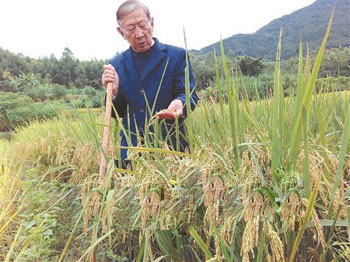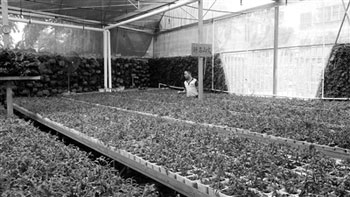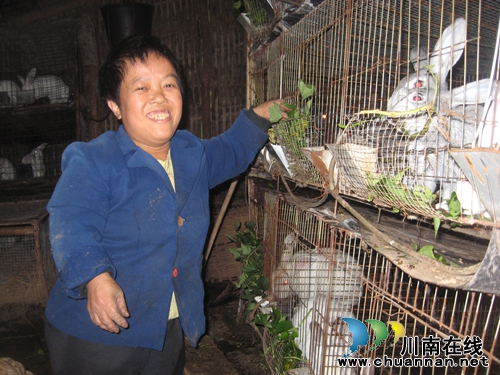The fragrance price of rice with sweet-scented osmanthus is 3 times that of ordinary.
Original title: the value of sweet-scented osmanthus-scented rice cultivated by an 80-year-old man is 3 times that of ordinary rice.

Pan Chengzu often goes to the fields to observe the development of rice.
Have you ever eaten rice with sweet-scented osmanthus fragrance? Although Pan Chengzu in Lushan Village, Lefeng Town, Nanan City has only a primary school education level, he has developed a high-quality late rice "Mei Wan No. 1" by self-study. In November 1991, he passed the technical appraisal and promotion of the Nan'an County Science and Technology Commission and the Agriculture Bureau. In the autumn of 2011, he successfully cultivated conventional high-quality late rice "Xiyanghong 1", which was determined by the Rice quality Identification Center of the Ministry of Agriculture and confirmed as a "second-class edible indica rice variety". As a result, his pace did not stop. In 2013, he cultivated natural sweet-scented osmanthus rice. The rice quality was affirmed by the Rice quality Identification Center of the Ministry of Agriculture, and all the indicators met the first and second standards. Yesterday, the reporter went to visit Mr. Pan and listened to him tell the story behind the cultivation of rice.
Cultivate sweet-scented osmanthus rice inspired by bee pollination
The successful cultivation of "Meiwan No. 1" has aroused the enthusiasm of Pan Chengzu's breeding. Around 2008, many people in the village raised bees and collected litchi honey. One day in late September of the same year, he found in the field that a group of bees had been going back and forth between the rice field and the sweet-scented osmanthus tree in the village, collecting both late rice pollen and sweet-scented osmanthus pollen. He analyzed according to the principle of cross breeding: "if late rice is pollinated by bees, it is possible for late rice to cross with sweet-scented osmanthus, will it become a kind of rice with natural sweet-scented osmanthus fragrance?"
Pan Chengzu, who has been committed to studying all kinds of fragrant rice such as Thai jasmine fragrant rice, Heilongjiang rice fragrant rice and Liaoning province popcorn fragrant rice, began to have a strong interest in cultivating sweet-scented osmanthus fragrant rice. "there are ten or twenty decades-old sweet-scented osmanthus trees in the village. The season of sweet-scented osmanthus blossoms coincides with the blooming of late rice." He said that in the autumn of 2009, he specially chose rice "Xiyanghong 3", which had been cultivated for more than 20 years, as a seed, planted it in the breeding field, pollinated by bees and sweet-scented osmanthus, and constantly observed and screened in the field. When the rice was full of branches, he pulled up each rice plant with roots and soil and took it home, selected several hybrid rice plants with a faint scent of sweet-scented osmanthus, and replanted them the next year. After five years of careful cultivation and screening, he finally cultivated the natural sweet-scented osmanthus rice "Xiyangxiang 1" in the autumn of 2013.
The yield per mu, which is worth 3 times as much as ordinary rice, is expected to increase again.
According to Pan Chengzu, the plant height of "Xiyang Xiang 1" is 1 meter, the ear length is 23 cm, the effective ear per mu is 150000, the total number of grains per ear is 150, and the seed setting rate is 92.9%. The 1000-grain weight is 26 grams, which is 7 grams heavier than the 19 grams of 1000 grains of other varieties, and the yield per mu can reach 450kg-500kg. Sweet-scented osmanthus rice has strong heredity, wide adaptability, easy to grow and can resist rice blast. The growth period is 138 days, which is one month less than 168 days of other common varieties.
"although the yield is not very outstanding, the economic value is three times that of ordinary rice." Pan Chengzu said that one jin of hybrid rice is worth about 3 yuan on the market, while "Xiyang Xiang No. 1" is worth 10 to 12 yuan per jin. It is estimated that the average yield of hybrid rice per mu is 500kg per mu, with a total value of 2000 yuan, while sunset incense per mu can be worth more than 6000 yuan, which can increase income by more than 4000 yuan.
Pan Chengzu said that last year, he also selected some Xiyangxiang 2 and Xiyangxiang 3 varieties with a yield of more than 650 kilograms per mu, and now they have failed to resist panicle neck blast. If they are tested for another two years, it is possible to cultivate Xiyangxiang special rice with a yield of 650 kilograms per mu.
Many indexes reach the first grade or it is the first fragrant rice variety in South China.
In the inspection report issued by the Rice and products quality Supervision and Inspection Test Center of the Ministry of Agriculture in February 2015 provided by Pan Chengzu, the reporter saw that the brown rice rate, milled rice rate, transparency, gel consistency and other indicators of "Xiyangxiang 1" reached the first class, meeting the quality requirements of ordinary edible long-grain indica rice varieties. He said that after two years of planting observation, Xiyangxiang 1 had plant height, panicle length, tillering ability, number of grains per spike, seed setting rate, 1000-grain weight, plant uniformity, and resistance to three major rice diseases (rice blast, bacterial leaf blight, bacterial leaf spot). The yield, rice quality and taste have all been stable.
He said that as far as he knows, "Xiyang Xiang 1" is likely to be the third fragrant rice variety in the country, the first is Daohuaxiang in Heilongjiang Province, and the second is Japonica Rice 1052 in Liaoning Province, also known as popcorn. "Xiyang Xiang 1" may be the first fragrant rice variety in southern China. In the process of cultivation, Nanan Municipal Party Committee and Municipal Government, Municipal Agricultural Office and Municipal Science and Technology Bureau allocated support and listed it as a special scientific research project of Nanan Science and Technology Bureau for key support.
Farmers in Lushan Village, who have grown and eaten "Sunset Xiang No. 1", praised the variety with a jingle: "Tian Tou Xiang, Chengtou Xiang, boiled in the pot more fragrant, ate a whole body of comfortable pine, and earned a lot more health in a season (Minnan dialect: a lot more)."
Lei Yanming, director of the agricultural technology station in Lefeng Town, said that "Xiyang Xiang No. 1" is fragrant rice, because it tastes like fragrant rice, but at present, the state can only test the quality of rice, not whether it belongs to fragrant rice, nor can it detect specific fragrance types. He said that fragrant rice is cultivated in a small amount in various places, and there is no way to popularize it on a large scale, because it is a conventional variety and is easy to mutate. (by reporter Wu Zhiming / / by Pan Chengzu / photo)
- Prev

The downtown villa has Tuhao Garden shed to grow immortal grass.
The downtown villa has Tuhao Garden shed to grow immortal grass.
- Next

The village director precisely helps women with severe disabilities to raise rabbits to get rich.
The village director precisely helps women with severe disabilities to raise rabbits to get rich.
Related
- A course of planting techniques and methods on how to grow carrots
- How to plant the latest tulips?
- Is it better to pick tea in the morning or in the afternoon? When is the best time for tea to be picked? what is the third or fifth tea?
- Launch Yuanxiao Happy combination Haocha + Tea Yuan healthy Taste
- Penghu Tourism "Fireworks 20 Parade with You"
- 2022 West Lake Happiness holds "Digital Revitalization Voucher" and draws iphone13 and laptop.
- Banqiao Fuzhou social houses are designed to change start-up combined with police elimination to create a safe and livable environment
- The convenient measure of "mechanical weeding" in Xinbei has been abused and the Agriculture Bureau has imposed heavy penalties on the illegal land consolidation.
- Changgeng University Joins Hands with Four Memory Factories to Rescue Memory Talent Shortage
- The list of Taiwan's top 100 MVP managers is listed by the Director-General of the Farmers' Association of Sanxia District.

